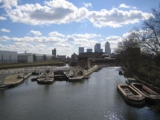
Bow Locks
Encyclopedia
Bow Locks (No20) is a set of bi-directional locks
in the London Borough of Tower Hamlets
. The locks link the tidal Bow Creek
to the River Lee Navigation
, which is a canalised river. These locks were first built in 1850 and then rebuilt in 1930, at the same time as the Prescott Channel
was cut nearby. At high tide, the tide from Bow Creek
formerly flowed through Bow Locks, to raise the level of the canals, such as the Limehouse Cut
. But in 2000, these locks were modified to keep the tide out, to reduce silting in the canal system.
In 2004–05, British Waterways
refurbished the historic footbridge over Bow Locks.
.
The nearest London Underground stations are Bromley-by-Bow
and West Ham.
Lock (water transport)
A lock is a device for raising and lowering boats between stretches of water of different levels on river and canal waterways. The distinguishing feature of a lock is a fixed chamber in which the water level can be varied; whereas in a caisson lock, a boat lift, or on a canal inclined plane, it is...
in the London Borough of Tower Hamlets
London Borough of Tower Hamlets
The London Borough of Tower Hamlets is a London borough to the east of the City of London and north of the River Thames. It is in the eastern part of London and covers much of the traditional East End. It also includes much of the redeveloped Docklands region of London, including West India Docks...
. The locks link the tidal Bow Creek
Bow Creek
Bow Creek is a long tidal estuary of the River Lea and is part of the Bow Back Rivers. Below Bow Locks the creek forms the boundary between the London Boroughs of Newham and Tower Hamlets, in east London....
to the River Lee Navigation
River Lee Navigation
The Lee Navigation is a canalised river incorporating the River Lea . Its course runs from Hertford Castle Weir all the way to the River Thames at Bow Creek. The first lock of the navigation is Hertford Lock the last being Bow Locks....
, which is a canalised river. These locks were first built in 1850 and then rebuilt in 1930, at the same time as the Prescott Channel
Prescott Channel
The Prescott Channel was built in 1930–35 as part of a flood relief scheme for the River Lee Navigation in the East End of London, and was named after Sir William Prescott, the then chairman of the Lee Conservancy Board...
was cut nearby. At high tide, the tide from Bow Creek
Bow Creek
Bow Creek is a long tidal estuary of the River Lea and is part of the Bow Back Rivers. Below Bow Locks the creek forms the boundary between the London Boroughs of Newham and Tower Hamlets, in east London....
formerly flowed through Bow Locks, to raise the level of the canals, such as the Limehouse Cut
Limehouse Cut
The Limehouse Cut is a straight, broad canal in the East End of London, which linked the lower reaches of the River Lee Navigation to the River Thames...
. But in 2000, these locks were modified to keep the tide out, to reduce silting in the canal system.
In 2004–05, British Waterways
British Waterways
British Waterways is a statutory corporation wholly owned by the government of the United Kingdom, serving as the navigation authority in England, Scotland and Wales for the vast majority of the canals as well as a number of rivers and docks...
refurbished the historic footbridge over Bow Locks.
Access and transport
There is pedestrian and cycle access via the towpath which also forms part of the Lea Valley WalkLea Valley Walk
The Lea Valley Walk is a long-distance path located between Leagrave, the source of the River Lea near Luton, and the Thames, at Limehouse Basin, Limehouse, east London. From its source much of the walk is rural. At Hertford the path follows the towpath of the River Lee Navigation, and it becomes...
.
The nearest London Underground stations are Bromley-by-Bow
Bromley-by-Bow tube station
Bromley-by-Bow tube station is a London Underground station on the Blackwall Tunnel Northern Approach Road in the Bromley-by-Bow neighbourhood of the London Borough of Tower Hamlets in east London, England. The station is on the District and Hammersmith & City lines, with both services sharing a...
and West Ham.
See also
- Canals of the United KingdomCanals of the United KingdomThe canals of the United Kingdom are a major part of the network of inland waterways in the United Kingdom. They have a colourful history, from use for irrigation and transport, through becoming the focus of the Industrial Revolution, to today's role for recreational boating...
- History of the British canal systemHistory of the British canal systemThe British canal system of water transport played a vital role in the United Kingdom's Industrial Revolution at a time when roads were only just emerging from the medieval mud and long trains of pack horses were the only means of "mass" transit by road of raw materials and finished products The...

